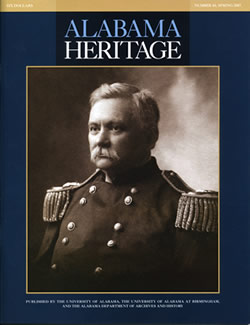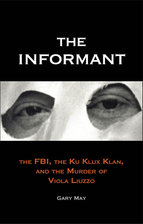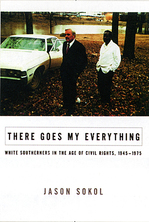|
On the cover: Former Alabama Governor William C. Oates served as a brigadier general in the Spanish-American War. (Courtesy the Alabama Department of Archives and History.)
|
FEATURE ABSTRACTS
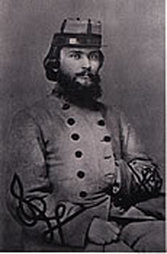 William C. Oates
William C. Oates(Alabama Department of
Archives and History)
Captain Oates and His Red-Shirted Boys
By Glenn W. LaFantasie
At the dawn of the Civil War, future Alabama governor William C. Oates organized a company of 121 men on the steps of the Abbeville court house. Though most of the men had no battlefield experience, they nevertheless enthusiastically marched northwards carrying dreams of glory and a strong devotion to the Confederacy. On their journey, these young men—known as Company G of the 15th Alabama—were introduced to the stark realities of a soldier’s life, facing death and hardship as they traveled closer to the war and were thrust into some of its most notorious battles. They would be immortalized at Gettysburg’s Little Round Top.
By Glenn W. LaFantasie
At the dawn of the Civil War, future Alabama governor William C. Oates organized a company of 121 men on the steps of the Abbeville court house. Though most of the men had no battlefield experience, they nevertheless enthusiastically marched northwards carrying dreams of glory and a strong devotion to the Confederacy. On their journey, these young men—known as Company G of the 15th Alabama—were introduced to the stark realities of a soldier’s life, facing death and hardship as they traveled closer to the war and were thrust into some of its most notorious battles. They would be immortalized at Gettysburg’s Little Round Top.
Additional Information
About the Author
Glenn W. LaFantasie, who received his PhD in History from Brown University, is the Richard Frockt Family Professor of Civil War History and Director of the Center for the Study of the Civil War in the West at Western Kentucky University. He is the author of Gettysburg Requiem: The Life and Lost Causes of Confederate Colonel William C. Oates (Oxford University Press, 2006), Twilight at Little Round Top (Wiley, 2005), and other works on the Civil War. Professor LaFantasie, who served as Deputy Historian of the U.S. Department of State in Washington from 1991 to 1995, has formerly taught at the University of Rhode Island, Gettysburg College, and the University of Maine at Farmington. His articles regularly appear in Civil War Times, North & South, American History, America’s Civil War, and MHQ: The Quarterly Journal of Military History. He lives with his wife, Donna, in Bowling Green, Kentucky. They have three grown children.
- Burnett, Edmund Cody, ed. “Letters of Barnett Hardeman Cody and Others, 1861–1864,” Georgia Historical Quarterly, 23 (1939), 265-299, 362-380.
- Jordan, William C. Some Events and Incidents During the Civil War (Montgomery, Ala.: Paragon Press, 1909).
- Laine, J. Gary and Morris M. Penny, Law’s Alabama Brigade in the War Between the Union and the Confederacy(Shippensburg, PA: White Mane, 1996).
- McClendon, William A. Recollections of War Times by an Old Veteran While Under Stonewall Jackson and Lieutenant General James Longstreet (1909).
- Oates, William C. The War Between the Union and the Confederacy and Its Lost Opportunities (New York and Washington, The Neale Publishing Co., 1905).
About the Author
Glenn W. LaFantasie, who received his PhD in History from Brown University, is the Richard Frockt Family Professor of Civil War History and Director of the Center for the Study of the Civil War in the West at Western Kentucky University. He is the author of Gettysburg Requiem: The Life and Lost Causes of Confederate Colonel William C. Oates (Oxford University Press, 2006), Twilight at Little Round Top (Wiley, 2005), and other works on the Civil War. Professor LaFantasie, who served as Deputy Historian of the U.S. Department of State in Washington from 1991 to 1995, has formerly taught at the University of Rhode Island, Gettysburg College, and the University of Maine at Farmington. His articles regularly appear in Civil War Times, North & South, American History, America’s Civil War, and MHQ: The Quarterly Journal of Military History. He lives with his wife, Donna, in Bowling Green, Kentucky. They have three grown children.
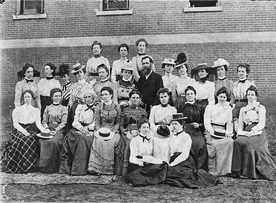 The first faculty of the
The first faculty of theAlabama Girls' Industrial School
(University of Montevallo)
Montevallo: Mound in a Valley
By Alissa Nutting
From the earliest Creek inhabitants and Jacksonian pioneers who revered Montevallo for its beauty and fertility, a unique appreciation and spirit has long surrounded the city. As Montevallo developed over time into a lively town of commerce and community, residents began to nurture their love for the area into a vision of education, industry, faith, and recreation. An exploration of the city’s past reveals how present-day Montevallo has stayed true to the preservation of its many riches.
Additional Information
City of Montevallo
University of Montevallo
Shelby County Historical Society
About the Author
Alissa Nutting is an Assistant Editor at Alabama Heritage. She lives in Tuscaloosa where she is an MFA candidate at the University of Alabama and editor of the Black Warrior Review. Her fiction has appeared in various literary journals includingSwink, The Southeast Review, Ecotone, and Versal, and is forthcoming in a short-story anthology from Tin House Books. The author wishes to thank Marshall Goggins, Bobby Joe Seales, and the inspiration of Eloise Merony’s book Montevallo: The First One Hundred Years for being invaluable resources.
By Alissa Nutting
From the earliest Creek inhabitants and Jacksonian pioneers who revered Montevallo for its beauty and fertility, a unique appreciation and spirit has long surrounded the city. As Montevallo developed over time into a lively town of commerce and community, residents began to nurture their love for the area into a vision of education, industry, faith, and recreation. An exploration of the city’s past reveals how present-day Montevallo has stayed true to the preservation of its many riches.
Additional Information
City of Montevallo
University of Montevallo
Shelby County Historical Society
- Alabama Girls’ Technical Institute Bulletin. (The Institute, 1915–1916).
- Annual Catalogue of the Girls’ Industrial School of Alabama. Montevallo, AL: The School, (Columbia, S.C. : Bryan Ptg.), 1897–1898. (Times Printing Co., 1990).
- “Early Days In and Around Montevallo.” Montevallo News. 1895. The Shelby Chronicle. 1897. Shelby County Historical Society. Copied by Bobby Joe Seales 1898. .
- Getting acquainted with Shelby County : an introductory resource study. (Alabama College, 1945).
- Griffith, Lucille. Alabama College, 1896–1969. (Montevallo, AL: 1969).
- Harrison, Fairfax. The Independent Woman; An Address Before the Alabama Girl’s Technical Institute, Montevallo, Alabama, October 17, 1914. (Washington: 1914).
- Johnson, Golda W. The Lives and Times of Kingswood in Alabama: 1817–1890. (University of Montevallo, 1976).
- Kelly, Maggie Lou. A History of the First United Methodist Church of Montevallo: 1818–1979. (Times Printing Co., 1979).
- Meroney, Eloise. Montevallo: The First One Hundred Years. (Times Printing Co., 1977).
- National Federation of Business and Professional Women’s Clubs. A study of the employability of women in Alabama, 1929–1935 : a study / conducted by the National Federation of Business and Professional Women’s Clubs, Inc., and the Alabama Federation of Business and Professional Women’s Clubs, in cooperation with Alabama College. (Alabama College, 1936).
- The One Hundred and Twenty-Fifth Anniversary of the Battles of Montevallo and Bibb Furnace: March 31 & April 1, 1990. (Times Printing Co., 1990).
- Steckel, Minnie L. The Alabama Business Woman as Citizen. A Study Conducted by the Alabama Federation of Business and Professional Women’s Clubs in Collaboration with Alabama College, Montevallo, Alabama. (Alabama College, 1937).
- Tipton, Mary Frances. Years Rich and Fruitful: University of Montevallo 1896–1996. (University of Montevallo, 1996).
- Welcome to Alabama College at Montevallo. (The College, 1900).
- Shelby County
- Rufus W. Cobb
- Little Cahaba Iron Works
- Wilson’s Raid
- University of Montevallo
- Julia S. Tutwiler
- Alabama Girl’s Industrial School Students
- Alabama College to University of Montevallo
- American Village
About the Author
Alissa Nutting is an Assistant Editor at Alabama Heritage. She lives in Tuscaloosa where she is an MFA candidate at the University of Alabama and editor of the Black Warrior Review. Her fiction has appeared in various literary journals includingSwink, The Southeast Review, Ecotone, and Versal, and is forthcoming in a short-story anthology from Tin House Books. The author wishes to thank Marshall Goggins, Bobby Joe Seales, and the inspiration of Eloise Merony’s book Montevallo: The First One Hundred Years for being invaluable resources.
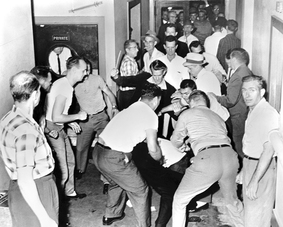 George Webb is beaten by a mob of Klansmen
George Webb is beaten by a mob of Klansmen(Birmingham Post-Herald and
Bettmann/CORBIS)
Shot Seen ‘Round the World: The Tommy Langston Photo
By Clarke Stallworth
On May 14, 1961, Birmingham Post-Herald photographer Tommy Langston waited for the Freedom Riders to arrive in the Birmingham Trailways bus station. The Freedom Riders had already been attacked on their journey south, and Langston was prepared for a scene. What he did not know, however, was that the violence he would document that day would go on to endanger his life and alter the course of a revolution.
Additional Information
NPR: The Freedom Riders of 1961
The following articles in the Encyclopedia of Alabama will also be of interest:
Multimedia:
About the Author
The son of a country doctor in Thomaston, Alabama, Clarke Stallworth attended Marion Institute, Emory University, and received his BA in journalism from the University of North Carolina. He was city editor of the Birmingham Post-Herald and managing editor and columnist at the Birmingham News. For the past twenty years, he has been a newspaper consultant, visiting more than one hundred daily newspapers and giving more than five hundred workshops for press associations. He has made thirty-three presentations at the Alabama Press Institute in Reston, Virginia. He has taught journalism at the University of Alabama in Tuscaloosa, the University of Alabama at Birmingham, Samford University, and Jacksonville State University. He is the author of three books on Alabama history. He is married to Anne Nall Stallworth, author of three published novels. They have two children and three grandchildren.
By Clarke Stallworth
On May 14, 1961, Birmingham Post-Herald photographer Tommy Langston waited for the Freedom Riders to arrive in the Birmingham Trailways bus station. The Freedom Riders had already been attacked on their journey south, and Langston was prepared for a scene. What he did not know, however, was that the violence he would document that day would go on to endanger his life and alter the course of a revolution.
Additional Information
NPR: The Freedom Riders of 1961
The following articles in the Encyclopedia of Alabama will also be of interest:
Multimedia:
About the Author
The son of a country doctor in Thomaston, Alabama, Clarke Stallworth attended Marion Institute, Emory University, and received his BA in journalism from the University of North Carolina. He was city editor of the Birmingham Post-Herald and managing editor and columnist at the Birmingham News. For the past twenty years, he has been a newspaper consultant, visiting more than one hundred daily newspapers and giving more than five hundred workshops for press associations. He has made thirty-three presentations at the Alabama Press Institute in Reston, Virginia. He has taught journalism at the University of Alabama in Tuscaloosa, the University of Alabama at Birmingham, Samford University, and Jacksonville State University. He is the author of three books on Alabama history. He is married to Anne Nall Stallworth, author of three published novels. They have two children and three grandchildren.
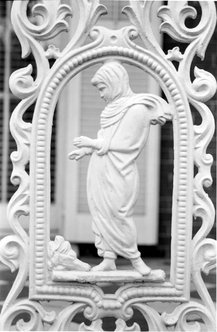 The figure of Winter
The figure of Winterfrom the Richards House verandah
(Sheila Hagler)
Ornamental Ironwork—Signature of Antebellum Mobile
By John Sledge
Photography by Sheila Hagler
Early Mobile's bare, simple streets matched its lack of prosperity. But after Alabama's statehood, the city's ports began to thrive and the face of Mobile changed accordingly. As the city became richer and more populated, business owners imported large amounts of iron from northern foundries to make impressive decorations for their establishments. Through much of the nineteenth century, the trade of ornamental ironwork grew quickly in Mobile, infusing the city's austere beginnings with the unique, lush verandas and building-sides it is still renowned for today.
Additional Information
The following articles in the Encyclopedia of Alabama will also be of interest:
About the Author
John Sledge was born in Gainesville, Florida, in 1957 and moved with his family to central Alabama in 1962. He grew up in Montevallo but has deep roots on the Gulf Coast. His mother lived in the Pontalba Building in New Orleans as a child, and his father grew up in Georgia Cottage on Springhill Avenue, home of Victorian authoress Augusta Evans Wilson. Sledge holds a BA in history and Spanish from Auburn University and a master’s degree in historic preservation from Middle Tennessee State University. He is an architectural historian with the Mobile Historic Development Commission, where he has worked since 1985. He is the author of two books, Cities of Silence: A Guide to Mobile’s Historic Cemeteries (University of Alabama Press, 2002) and An Ornament to the City: Old Mobile Ironwork (University of Georgia Press, 2006). In addition, Sledge is Books editor for the Mobile Press-Register. He lives in Fairhope with his wife and daughter. This article is adapted from John Sledge’s new book, An Ornament to the City: Old Mobile Ironwork, published by the University of Georgia Press. Publication of this book was made possible in part by a grant from the A. S. Mitchell Foundation.
Sheila Hagler, who resides in Grand Bay, Alabama, is a fine art photographer specializing in black and white. For nine years, she has taught students (middle and high school) in south Mobile County as an artist in residence for the Alabama State Council on the Arts. Her program, Merging of Cultures, produced the post-Katrina exhibition, "Eyes of the Storm." Hagler is also one of three women featured in a PBS documentary airing nationwide this year, "Living Courageously: The Spirit of Women." Hagler was nominated because of her work with at-risk, post-Katrina children in Bayou La Batre.
By John Sledge
Photography by Sheila Hagler
Early Mobile's bare, simple streets matched its lack of prosperity. But after Alabama's statehood, the city's ports began to thrive and the face of Mobile changed accordingly. As the city became richer and more populated, business owners imported large amounts of iron from northern foundries to make impressive decorations for their establishments. Through much of the nineteenth century, the trade of ornamental ironwork grew quickly in Mobile, infusing the city's austere beginnings with the unique, lush verandas and building-sides it is still renowned for today.
Additional Information
The following articles in the Encyclopedia of Alabama will also be of interest:
About the Author
John Sledge was born in Gainesville, Florida, in 1957 and moved with his family to central Alabama in 1962. He grew up in Montevallo but has deep roots on the Gulf Coast. His mother lived in the Pontalba Building in New Orleans as a child, and his father grew up in Georgia Cottage on Springhill Avenue, home of Victorian authoress Augusta Evans Wilson. Sledge holds a BA in history and Spanish from Auburn University and a master’s degree in historic preservation from Middle Tennessee State University. He is an architectural historian with the Mobile Historic Development Commission, where he has worked since 1985. He is the author of two books, Cities of Silence: A Guide to Mobile’s Historic Cemeteries (University of Alabama Press, 2002) and An Ornament to the City: Old Mobile Ironwork (University of Georgia Press, 2006). In addition, Sledge is Books editor for the Mobile Press-Register. He lives in Fairhope with his wife and daughter. This article is adapted from John Sledge’s new book, An Ornament to the City: Old Mobile Ironwork, published by the University of Georgia Press. Publication of this book was made possible in part by a grant from the A. S. Mitchell Foundation.
Sheila Hagler, who resides in Grand Bay, Alabama, is a fine art photographer specializing in black and white. For nine years, she has taught students (middle and high school) in south Mobile County as an artist in residence for the Alabama State Council on the Arts. Her program, Merging of Cultures, produced the post-Katrina exhibition, "Eyes of the Storm." Hagler is also one of three women featured in a PBS documentary airing nationwide this year, "Living Courageously: The Spirit of Women." Hagler was nominated because of her work with at-risk, post-Katrina children in Bayou La Batre.
DEPARTMENT ABSTRACTS
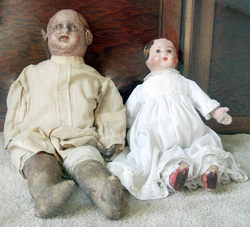 Ella Smith's creations now survive
Ella Smith's creations now surviveprimarily in museums and private collections
(Museum of East Alabama)
Alabama Treasures
Ella Smith and the Alabama Indestructible Doll
By Susan Hales
The eccentric Ella Smith of Roanoke, an art instructor and amateur inventor, was one of few women who held patents in the early twentieth century. After her retirement Smith pursued a goal to produce an indestructible doll for children. Because of Smith’s artistic skill and business sense, her creations have since proved to have a value as durable as the dolls themselves.
Additional Information
The following items in the Encyclopedia of Alabama will also be of interest:
About the Author
Susan Warley Hales is an artist and writer living in Mobile, Alabama, where she recently received her BFA in Studio Art with a thesis show in which dolls were used to represent her family stories. In researching and purchasing the dolls for the paintings she became aware of the Alabama Indestructible Doll of Roanoke. Susan will complete her MA in Creative Writing in June 2007 from the University of South Alabama where she currently works at the University Library.
Ella Smith and the Alabama Indestructible Doll
By Susan Hales
The eccentric Ella Smith of Roanoke, an art instructor and amateur inventor, was one of few women who held patents in the early twentieth century. After her retirement Smith pursued a goal to produce an indestructible doll for children. Because of Smith’s artistic skill and business sense, her creations have since proved to have a value as durable as the dolls themselves.
Additional Information
The following items in the Encyclopedia of Alabama will also be of interest:
- Randolph County
- Roanoke Doll (image)
About the Author
Susan Warley Hales is an artist and writer living in Mobile, Alabama, where she recently received her BFA in Studio Art with a thesis show in which dolls were used to represent her family stories. In researching and purchasing the dolls for the paintings she became aware of the Alabama Indestructible Doll of Roanoke. Susan will complete her MA in Creative Writing in June 2007 from the University of South Alabama where she currently works at the University Library.
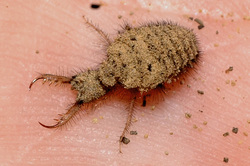 A freshly dug-up doodlebug
A freshly dug-up doodlebug(W. Mike Howell)
Nature Journal
Doodlebugs and Antlions
By L. J. Davenport
Many people worldwide share the common childhood memory of lying by the hole of a doodlebug and urging it to come out with a rhyming plea. Larry Davenport describes the life process of the doodlebug and also accounts for the cultural significance of the ever-present insect, discussing its many appearances in literature as well as the variations of doodlebug rhymes across the globe.
Additional Information
The following article in the Encyclopedia of Alabama will also be of interest:
About the Author
Larry Davenport is a professor of biology at Samford University, Birmingham.
Doodlebugs and Antlions
By L. J. Davenport
Many people worldwide share the common childhood memory of lying by the hole of a doodlebug and urging it to come out with a rhyming plea. Larry Davenport describes the life process of the doodlebug and also accounts for the cultural significance of the ever-present insect, discussing its many appearances in literature as well as the variations of doodlebug rhymes across the globe.
Additional Information
The following article in the Encyclopedia of Alabama will also be of interest:
About the Author
Larry Davenport is a professor of biology at Samford University, Birmingham.
Reading the Southern Past
White Folks and the Civil Rights Movement
By Stephen Goldfarb
Jason Sokol and Gary May have each published books on the white response to the civil rights movement, There Goes My Everything: White Southerners in the Age of Civil Rights, 1945–1975 and The Informant: The FBI, the Ku Klux Klan, and the Murder of Viola Liuzzo, respectively. Stephen Goldfarb summarizes both works and discusses the differing focus in each one.
Additional Information
The following articles in the Encyclopedia of Alabama will also be of interest:
About the Author
Stephen Goldfarb holds a PhD in the history of science and technology. He retired from a public library in 2003.
White Folks and the Civil Rights Movement
By Stephen Goldfarb
Jason Sokol and Gary May have each published books on the white response to the civil rights movement, There Goes My Everything: White Southerners in the Age of Civil Rights, 1945–1975 and The Informant: The FBI, the Ku Klux Klan, and the Murder of Viola Liuzzo, respectively. Stephen Goldfarb summarizes both works and discusses the differing focus in each one.
Additional Information
The following articles in the Encyclopedia of Alabama will also be of interest:
- Modern Civil Rights Movement in Alabama
- Selma to Montgomery March
- Segregation (Jim Crow)
- Viola Gregg Liuzzo
- Viola Gregg Liuzzo (video)
- William ‘W.C.’ Handy
About the Author
Stephen Goldfarb holds a PhD in the history of science and technology. He retired from a public library in 2003.
